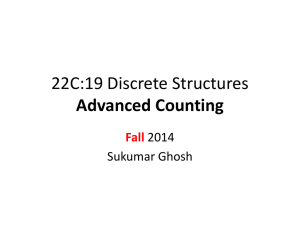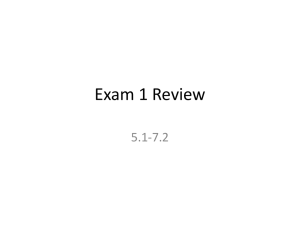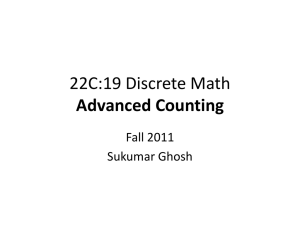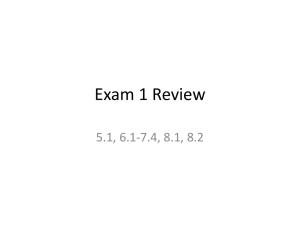+ N - 大葉大學
advertisement
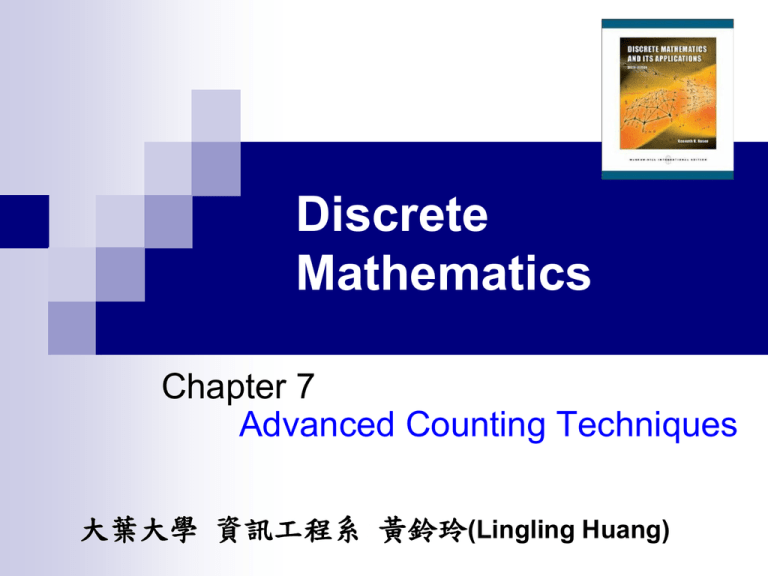
Discrete
Mathematics
Chapter 7
Advanced Counting Techniques
大葉大學 資訊工程系 黃鈴玲(Lingling Huang)
Outline
7.1 Recurrence Relations
7.2 Solving Linear Recurrence Relations
7.4 Generating Functions
7.5 Inclusion-Exclusion
7.6 Applications of Inclusion-Exclusion
Ch9-2
7.1 Recurrence Relations(遞迴關係)
Example 1. Let {an} be a sequence that satisfies
the recurrence relation an=an-1-an-2 for n=2,3,…, and
suppose that a0=3,and a1=5.
Here a0=3 and a1=5 are the initial conditions.
By the recurrence relation,
a2 = a1-a0 = 2
a3 = a2-a1 = -3
a4 = a3-a2 = -5
:
Q1: Applications ?
Q2: Are there better ways for computing the terms of
{an}?
Ch7-3
※Modeling with Recurrence Relations
We can use recurrence relations to model (describe) a
wide variety of problems.
Example 3. Compound Interest (複利)
Suppose that a person deposits(存款) $10000 in
a saving account at a bank yielding 11% per year with
interest compounded annually.
How much will be in the account after 30 years ?
Sol : Let Pn denote the amount in the account
after n years.
P0=10000
Pn=Pn-1 + 0.11Pn-1=1.11 Pn-1,
∴ P30=1.11 P29=(1.11)2 P28=…=(1.11)30 P0
=228922.97
Ch7-4
Example 5. (The Tower of Hanoi)
The rules of the puzzle allow disks to be moved one at a time
from one peg to another as long as a disk is never placed on
top of a smaller disk. Let Hn denote the number of moves
needed to solve the Tower of Hanoi problem with n disks.
Set up a recurrence relation for the sequence {Hn}.
目標 : n 個disk都從 peg 1 移到 peg 2
H4 moves
peg 1
Sol :
peg 2
peg 3
Hn=2Hn-1+1, H1=1
( n-1個 disk 先從peg 1→peg 3, 第 n 個 disk 從 peg 1→peg 2,
n-1個 disk 再從 peg 3→peg 2)
Ch7-5
上例中 Hn=2Hn-1+1, H1=1
∴Hn=2Hn-1+1
=2(2Hn-2+1)+1
=22Hn-2+2+1
=22(2Hn-3+1)+2+1
=23Hn-3+(22+2+1)
:
=2n-1H1+(2n-2+2n-3+…+1)
=2n-1+2n-2+…+1
2n - 1 n
=
=2 -1
2 -1
Ch7-6
Example 6. Find a recurrence relation and give initial
conditions for the number of bit strings of length n
that do not have two consecutive 0s.
How many such bit strings are there of length 5 ?
Sol :
Let an be the number of bit strings of length n that
do not have two consecutive 0s.
1
2
…
n-3 n-2 n-1
1
an-1 種
an-2 種
n
1
0
∴ a3=a2+a1=5, a4=8, a5=13
∴ an = an-1+an-2, n 3
a1=2 (string : 0,1)
a2=3 (string : 01,10,11)
Ch7-7
Example 7. (Codeword enumeration)
A computer system considers a string of decimal
digits a valid codeword if it contains an even
number of 0 digits. Let an be the number of valid
n-digit codewords.
Find a recurrence relation for an.
Sol :
1
2
3
…
n-1
an-1 種
10n-1 - an-1 種
n
1~9
∴ an = 9an-1 + (10n-1-an-1)
= 8an-1 + 10n-1
, n2
a1 = 9
0
Ch7-8
求an通解 :
an 8an-1 10n-1 8(8an-2 10n-2 ) 10n-1
82 an-2 (8 10n-2 10n-1 )
83 an-3 (82 10n-3 8 10n-2 10n-1 )
8n-1 a1 (8n-2 10 8n-3 102 ... 8 10n-2 10n-1 )
8n (8n-1 8n-2 10 8n-3 102 ... 8 10n-2 80 10n-1 )
10
首項8n-1 , 公比為 , 共有 n項
8
n -1 10 n
8 (( ) - 1)
n
n
n -1 10 n
8
8
8 4 8 ( ) - 4 8n -1
10
8
( - 1)
8
Exercise : 3,23,25,27,29,41
1
n
n -1
10 4 8
(41推廣成n)
2
Ch7-9
7.2 Solving Recurrence Relations
Def 1. A linear homogeneous recurrence relation of
degree k (i.e., k terms) with constant coefficients
is a recurrence relation of the form
an = c1an-1+c2an-2+…+ckan-k
where ciR and ck≠0
Example 1 and 2.
fn = fn-1 + fn-2
an = an-5
an = an-1 + an-22
an = nan-1
Hn = 2Hn-1 + 1
(True, deg=2)
(True, deg=5)
(False, not linear)
(False , not linear)
(False, not homogeneous)
Ch7-10
Solving Linear Homogeneous Recurrence
Relations with Constant Coefficients
Theorem 1.
Let an = c1an-1+ c2an-2 be a recurrence relation
with c1,c2R.
If r2 - c1r - c2= 0 (稱為characteristic equation)
has two distinct roots r1 and r2.
Then the solution of an is an = a1r1n + a2r2n ,
for n=0,1,2,…, where a1 , a2 are constants.
(a1 , a2可利用 a0, a1算出)
Ch7-11
Example 3.
What’s the solution of the recurrence relation
an = an-1 + 2an-2
with a0=2 and a1=7 ?
Sol :
The characteristic equation is r2 – r - 2=0.
Its two roots are r1= 2 and r2 = -1.
r 與r 順序可交換,
Hence an=a12n +a2 (-1)n .
結果會一樣
∵a0 = a1a2 = 2, a1=2a1-a2=7
∴a1 = 3, a2 = -1
驗算:a2 = a1 + 2a0 =11
a2= 322 - 1 =11
an = 32n - (-1)n.
1
2
Ch7-12
Example 4. Find an explicit formula for the
Fibonacci numbers.
Sol :
fn = fn-1 + fn-2 , n 2, f0=0 , f1=1.
The characteristic equation is r2 - r - 1=0.
1- 5
1 5
r2
Its two roots are r1 2 ,
2 .
So we have
1 5 n
1- 5 n
f n a1 (
) a2 (
)
2
2
1 5
1- 5
) a2 (
) 1
f 0 a1 a 2 0, f1 a1 (
2
2
1
-1
a1
, a2
5
5
1
1 5 n
-1 1 - 5 n
fn
(
)
(
)
2
2
5
5
Ch7-13
Thm 2.
Let an = c1an-1+c2an-2 be a recurrence relation
with c1,c2R.
If r2 - c1r - c2= 0 has only one root r0 .
Then the solution of an is
an = a1 r0n + a2 n r0n
for n=0,1,2,…, where a1 and a2 are constants.
Ch7-14
Example 5.
What’s the solution of an= 6an-1 - 9an-2
with a0=1 and a1=6 ?
Sol :
The root of r2 - 6r + 9 = 0 is r0 = 3.
Hence an = a1.3n +a2.n.3n .
∵a0 = a1 = 1
a1 = 3a1 + 3a2 = 6
∴ a1 = 1 and a2 = 1
驗算:a2 = 6a1 - 9a0 =27
n
n
an = 3 + n.3
a2= 32 +2 32 =27
Ch7-15
Thm 3.
Let an = c1an-1 + c2an-2 + … + ckan-k be a
recurrence relation with c1, c2, …, ck R.
If rk - c1rk-1 - c2rk-2 -…- ck = 0 has k distinct
roots r1, r2,…, rk.
Then the solution of an is
an = a1r1n +a2r2n + …+akrkn, for n = 0, 1, 2, …
where a1, a2,…ak are constants.
Ch7-16
Example 6 (k = 3)
Find the solution of an = 6an-1 - 11an-2 + 6an3
with initial conditions a0=2, a1=5 and a2=15 .
Sol :
The roots of r3 - 6r2 + 11r – 6 = 0 are
r1 = 1, r2 = 2, and r3 = 3
∴an = a1 1n + a2 2n + a3 3n
a1 = 1,
∵a0 = a1 + a2 + a3 = 2
a2 = -1,
a1 = a1 + 2a2 + 3a3 = 5
a3 = 2
a2 = a1 + 4a2 + 9a3 = 驗算:a
15 3 = 6a2 - 11a1+ 6a0 =47
a3= 1 - 23 + 2 33 =47
n
n
∴an = 1 - 2 + 2 3
Ch7-17
Thm 4.
Let an = c1an-1 + c2an-2 + … + ckan-k be a recurrence
relation with c1, c2, …, ck R.
If rk - c1rk-1 - c2rk-2 - … - ck = 0 has
t distinct roots r1, r2, …, rt
with multiplicities m1, m2, …, mt respectively,
where mi 1,i, and m1+ m2 +…+ mt = k,
then
n
m -1
an (α1,0 α1,1 n ... α1,m1 -1 n
1
(α2,0 α2 ,1 n ... α2 ,m2 -1 n
)r1
m2 -1
... (αt,0 αt,1 n ... αt,mt -1 n
) r2
mt -1
n
) rt
n
where ai,j are constants for 1 i t and 0 j mi-1.
Ch7-18
補充說明:
若特徵方程式的root為:1 (2重根),
-2 (3重根),
3 (無重根)
則上述定理給出的通解為:
an= (a1,1+ a1,2 n) 1n+ (a2,1+ a2,2 n + a2,3 n2) (-2)n
+a3,1 3n
(其實變數a的下標可從1開始排起,只要不重複就好)
an= (a1+ a2 n) 1n+ (a3+ a4 n + a5 n2) (-2)n +a6 3n
Ch7-19
Example 8. Find the solution to the recurrence
relation an = -3an-1 - 3an-2 - an-3 with initial conditions
a0 = 1, a1 = -2 and a2 = -1.
Sol :
r3 + 3r2 + 3r + 1 = 0 has a single root r0 = -1 of
multiplicity three.
∴ an = (a1+a2n+a3n2) r0n = (a1+a2n+a3n2)(-1)n
∵ a0 = a1 = 1
a1 = (a1+a2+a3) (-1) = -2
a2 = a1+2a2+4a3 = -1
驗算:a3 = - 3a2 - 3a1- a0 =8
2)(-1)3 =8
a
=
(1+33-23
3
∴a1 = 1, a2 = 3, a3 = -2
an = (1+3n-2n2) (-1)n
Exercise : 3,13,15,19 Ch7-20
Linear Nonhomogeneous Recurrence
Relations with Constant Coefficients
Example: an = 3an-1 + 2n
A recurrence relation of the form
an = c1an-1 + c2an-2 + … + ckan-k + F(n),
where c1, c2, …, ck are real numbers
and F(n) is a function not identically zero depending
only on n.
The recurrence relation
an = c1an-1 + c2an-2 + … + ckan-k
is called the associated homogeneous recurrence
relation.
Ch7-21
Example 9:
an = an-1 + 2n,
associated h.r.r an = an-1
an = an-1 + an-2 + n2+1, associated h.r.r an = an-1 + an-2
an = 3an-1 + n3n, associated h.r.r an = 3an-1
an = an-1 + an-3 + n!, associated h.r.r an = an-1 + an-3
Ch7-22
Theorem 5. If {an (p)} is a particular solution (特解)
of an = c1an-1 + c2an-2 + … + ckan-k + F(n),
then every solution is of the form {an (p) + an (h)},
where {an (h)} is a solution of
an = c1an-1 + c2an-2 + … + ckan-k
Proof. If {an (p)} and {bn} are both solutions of
an = c1an-1 + c2an-2 + … + ckan-k + F(n),
then an(p) = c1an-1(p) + c2an-2 (p)+ … + ckan-k(p) + F(n),
and bn = c1bn-1 + c2bn-2 + … + ckbn-k + F(n).
an(p) - bn = c1(an-1 - bn-1) + c2(an-2 - bn-2) + …
+ ck(an-k - bn-k)
{an(p) - bn} is a solution of an = c1an-1 + c2an-2 + … + ckan-k
bn = an(p) + an (h)
Ch7-23
Example 10. Find all solutions of the recurrence
relation an = 3an-1 + 2n. What is the solution with a1=3?
Sol :
{associated的部分 an = 3an-1 先解}
Characteristic equation: r – 3 = 0 r = 3 an(h) = a 3n.
{particular solution}
∵ F(n) = 2n ∴ Let an(p) =cn+d, where c, d R.
If an(p) = cn+d is a solution to an = 3an-1 + 2n,
then cn+d = 3(c(n-1)+d)+2n =3cn - 3c 3d +2n
2cn-3c 2d +2n = (2c+2)n + (2d-3c) = 0 (任何n代入都需為0)
∴2c+2 = 0, and 2d-3c = 0 c = -1, d = -3/2
an(p) = -n - 3/2 an = an(h) an(p) = a 3n-n - 3/2
If a1= a 3-1 - 3/2 = 3 a = 11/6
an = (11/6) 3n- n - 3/2
Ch7-24
Example 11. Find all solutions of the recurrence
relation an = 5an-1 -6an-2 + 7n.
Sol :
{associated的部分 an = 5an-1 -6an-2 先解}
Characteristic equation: r2 – 5r + 6 = 0
r1 = 3, r2 = 2
an(h) = a1 3n + a2 2n.
{particular solution}
∵ F(n) = 7n ∴ Let an(p) = c7n, where c R.
If an(p) = c7n is a solution to an = 5an-1 -6an-2 + 7n,
then c7n = 5c7n-1 - 6c7n-2 + 7n
49c = 35c - 6c + 49
Exercise : 23
c = 49/20 an(p) = (49/20) 7n
an = an(h) an(p) = a1 3n + a2 2n + (49/20) 7n
Ch7-25
Theorem 6.
an = c1an-1 + c2an-2 + … + ckan-k + F(n),
where F(n) = (btnt + bt-1nt-1 +…+ b1n + b0)sn.
When s is not a root of the characteristic equation
of the associated linear homogeneous
recurrence relation, there is a particular solution
of the form
(ptnt + pt-1nt-1 +…+ p1n + p0)sn.
When s is a root of the characteristic equation
and its multiplicity is m, there is a particular
solution of the form
nm(ptnt + pt-1nt-1 +…+ p1n + p0)sn.
Ch7-26
Example 12. What form does a particular solution of
the linear nonhomogeneous recurrence relation
an = 6an-1 - 9an-2 + F(n) have when F(n) =3n, F(n) =n3n,
F(n) =n22n , and F(n) = (n2+1)3n.
Sol :
The associated linear homogeneous recurrence
relation is an = 6an-1 - 9an-2.
characteristic equation: r2 - 6r 9 = 0 r = 3 (2重根)
F(n) =3n, and 3 is a root an(p) = p0n23n
F(n) =n3n, and 3 is a root an(p) = n2(p1n+p0) 3n
F(n) =n22n , and 2 is not a root an(p) = (p2n2+p1n+p0)2n
F(n) = (n2+1)3n , and 3 is a root
an(p) = n2 (p2n2+p1n+p0) 3n
Exercise : 27
Ch7-27
Example 13. Find the solutions of the recurrence
relation an = an-1 + n with a1=1.
Sol : The associated linear homogeneous recurrence
relation is an = an-1 .
characteristic eq.: r - 1 = 0 r = 1 an(h) = c(1)n=c
F(n) = n = n(1)n, and 1 is a root
an(p) = n(p1n+p0)1n = p1n2+p0n
將an(p)代入an = an-1 + n
p1n2+p0n = p1(n-1)2+p0(n-1)+n
(2p1-1)n+p0-p1=0
p1= ½,
an(p) = (n2+n)/2
an = an(p) + an(h) = (n2+n)/2+c
p0 p1= ½
Exercise : 29
a1=1 c=0 an = an(p) + an(h) = (n2+n)/2
Ch7-28
ex 40: Solve the simultaneous recurrence relations
an = 3an-1 + 2bn-1
bn = an-1 + 2bn-1
with a0 = 1 and b0 = 2.
Sol :
an -bn= 2an-1 bn = an-2an-1
an = 3an-1 + 2bn-1 = 3an-1 + 2an-1- 4an-2
an = 5an-1 - 4an-2
r2 - 5r 4 = 0
r = 1, 4
an = a1+a24n
a0 = a1+a2 = 1
a1 = a1+4a2 = 3a0 + 2b0 = 7
an= 24n-1
a1 = -1, a2 = 2
bn = an-2an-1= 24n-1-4n2 = 4n1
Ch7-29
7.4 Generating Functions.
Def 1. The generating function for the sequence
a0, a1, a2,… of real numbers is the infinite series
G(x) = a0 + a1x +… + anxn +…
=
k
a
x
k
k 0
(若數列{an} 是finite,可視為是infinite,但後面的項都
等於0)
Ch7-30
Example 1. Find the generating functions for
the sequences {ak} with
(1) ak= 3
(2) ak = k+1
(3) ak = 2k
Sol :
(1) G(x) = ak x 3x
k
k 0
k
k 0
(2) G(x) = ak x (k 1) x
k
k 0
k 0
k 0
k 0
k
k
k k
a
x
2
(3) G(x) = k
x
Ch7-31
Example 2. What is the generating function
for the sequence 1,1,1,1,1,1 ?
a0 a1 a2 a3 a4 a5 a6及之後都=0
Sol :
G(x) = ak x k = a0 + a1x + a2x2 + a3x3 +…
k 0
1 x x 2 ... x 5
(expansion,展開式)
x6 -1
x -1
(closed form)
Exercise : 2
Ch7-32
Example 3.
m
Let mZ+ and ak k ,for k = 0, 1, …, m.
What is the generating function for the sequence
a0, a1,…, am ?
Sol :
G(x) = a0 + a1x + a2x2 + … + amxm
m m m 2
m m
x x x
0 1 2
m
= (1+x)m
(by下面的二項式定理)
n
( x y ) n ( 0n ) x n (1n ) x n -1 y ... ( nn -1 ) xyn -1 ( nn ) y n ( nj ) x n - j y j
j 0
Ch7-33
Useful Facts About Power Series
Example 4.
1
The function f (x) = 1 - x is the generating
function of the sequence 1, 1, 1, …, because
k
1
2
x
= 1 + x + x + …=
when |x| < 1.
1- x
k 0
Example 5.
1
The function f (x) = 1 - ax is the generating
function of the sequence 1, a, a2, …, because
1
k
2
2
(ax) = 1 + ax + a x + …=
when |ax| < 1 for a≠0.
1 - ax
k 0
Exercise : 5(a)(b), 11(a)
Ch7-34
Theorem 1.
k
Let f(x) = ak x and g(x) =
k 0
k
b
x
k .
k 0
k
(
a
b
)
x
Then f(x) + g(x) = k k .
k 0
f(x) g(x) = (a0+a1x+a2x2 +…)(b0+b1x +b2x2+…)
= (a0b0)+(a0b1+a1b0) x+(a0b2+a1b1+a2b0) x2+…
k
k
= a j bk - j x
k 0 j 0
Ch7-35
Example 6.
Let f (x) =
1
2 .
1 - x )
Use Example 4 to find the
k
a
x
coefficients a0, a1, a2, … in the expansion f (x)= k .
k 0
Sol :
1
= 1 + x + x2 + …
1- x
k
k
1
k
k
k
a
b
x
1
x
(
k
1
)
x
=
2 = j k - j
1 - x ) k 0 j 0
k 0 j 0
k 0
ak = k+1
Ch7-36
Def 2.
Let uR and kN. Then the extended
binomial coefficient
u
k
is defined by
u u(u - 1)(u - 2)...(u - k 1) / k!, if k 0
k
1
if k 0
Example 7. Find
Sol :
- 2
3
and 132
- 2 (-2)( -3)( -4) / 3! -4
3
1 2 ( 1 - 1 - 3 ) / 3! 1
3
16
2 2 2
Ch7-37
Example 8
When the top parameter is a negative integer, the
extended binomial coefficient can be expressed in
terms of an ordinary binomial coefficient.
- n (-n)( -n - 1)...(-n - r 1)
r
r!
(-1) r (n)(n 1)...(n r - 1)
r!
(-1) r (n r - 1)!
r!(n - 1)!
( -1) r n r - 1
r
Ch7-38
Thm 2. (The Extended Binomial Theorem)
Let xR with |x|<1 and let uR, then
1 x )u uk x k
k 0
Ch7-39
Example 9. (跳過)
Find the generating functions for (1+x)-n and (1-x)-n
where nZ+
Sol : By the Extended Binomial Theorem,
n
1
-n
k
(1 x) x (-n)(-n - 1) ...(-n - k 1) x k
k 0 k
k 0 k!
(-1) k
(n) (n 1) ...(n k - 1) x k
k!
k 0
k 0
k n k - 1 k
x
(-1)
k
By replacing x by –x we have
n k - 1 k
-n
x
(1 - x)
k
k 0
- n
k n k - 1
Note: (-1)
k
k
Exercise : 11(b)(d)
Ch7-40
Counting Problems and Generating Functions
Generating functions can be used to count the number
of combinations of various types.
Example 10.
Find the number of solutions of e1 + e2 + e3 = 17,
where e1, e2, e3 are integers with 2 e1 5, 3 e2 6,
and 4 e3 7.
Sol : The number of solutions with the indicated
constraints is the coefficient of x17 in the expansion
of
(x2 + x3 + x4 + x5)(x3 + x4 + x5 + x6)(x4 + x5 + x6 + x7)
(即相當於找 e1, e2, e3 使 xe xe xe = x17)
1
2
3
(e1, e2, e3)=(4, 6, 7), (5, 5, 7), (5, 6, 6) 共3種
Ch7-41
Example 11.
In how many different ways can eight identical
cookies be distributed among three distinct children
if each child receives at least two cookies and no
more than four cookies?
Sol : The number of solutions is the coefficient of x8 in
the expansion of
(x2 + x3 + x4)3
(c1, c2, c3) = (2, 2, 4), (2, 3, 3), (2, 4, 2),
(3, 2, 3), (3, 3, 2), (4, 2, 2)
共6種
Exercise: 23
Ch7-42
※Using Generating Functions to solve
Recurrence Relations.
Example 16.
Solving the recurrence relation ak = 3ak-1 for
k=1,2,3,… and initial condition a0 = 2.
Sol :
另法: (by 7.2節Thm 1公式)
r – 3 = 0 r = 3 an = a 3n
∵ a0 = 2 = a
∴ an = 2 3 n
Ch7-43
Let G( x) a0 a1 x a2 x ... ak x be the
k 0
generating function for {ak}.
First note that ak = 3ak-1
2
k
ak x 3 ak -1 x 3x ak -1 x
k
k 1
k
k 1
k 1
k -1
3x ak x
k
k 0
從k = 1開始,以避免ak-1變成a-1
G(x) - a0 = 3x G(x)
∵a0 = 2 G(x) - 3x G(x) = G(x)(1-3x) = 2
2
G ( x)
2 (3x) k 2 3k x k
1 - 3x
k 0
k 0
∴ ak = 2 3k
Exercise : 5,7,11,33
Ch7-44
Example 17
Solving ak = 8ak-1 +10k-1 for k =1,2,3,… and initial
condition a1 = 9. (Sec. 7.1 Example 7)
Sol : Let a0 = 1 (為計算方便而假設).
2
k
G
(
x
)
a
a
x
a
x
...
a
x
k
0
1
2
Let
k 0
be the generating function for {ak}.
k 1
k 1
G( x) - 1 ak x k (8ak -1 10k -1 ) x k
k 0
k 0
8 ak -1 x k 10k -1 x k 8 x ak x k x10k x k
k 1
k 1
x
8 xG ( x)
1 - 10 x
Ch7-45
x
1- 9x
(1 - 8 x)G ( x) 1
1 - 10 x 1 - 10 x
1 - 9x
1
1
1
G ( x)
(
)
(1 - 10x)(1 - 8 x) 2 1 - 10x 1 - 8 x
1
1
k k
k k
(10 x 8 x ) (10k 8k ) x k
2 k 0
k 0
k 0 2
∴ ak = (10k + 8k)/2
Exercise: 33
Ch7-46
7.5 Inclusion-Exclusion 排容原理
A,B,C,D : sets
(1). A B A B - A B
(2). A B C A B C - A B - A C - B C A B C
A
|A|+|B|+|C| 時
各部分被計算的次數
1
2
1
B
1
2
3
1
0
2
1
21
1
-|AB|-|AC|-|BC|後
C
+|ABC|後
(3). A B C D ?
Ch7-47
Theorem 1.
A1, A2, …, An : sets
n
A1 A2 ... An Ai i 1
A A
1i j n
i
j
Ai A j Ak - ... (-1) n A1 A2 ... An
1i , j , k n
Exercise : 17
Ch7-48
7.6 Applications of Inclusion and
Exclusion
Example 1. How many solutions does x1 + x2 + x3 = 11
have, where x1, x2, x3 are nonnegative integers with
x1 3, x2 4, and x3 6?
Sol :
Let a solution have property P1 if x1 4, property P2 if
x2 5, and property P3 if x3 7.
N(P1’P2’P3’) = N - N(P1) - N(P2) - N(P3) + N(P1P2)
+ N(P2P3) + N(P1P3) - N(P1P2P3)
11 2 - 7 2 - 6 2 - 4 2 2 2 0 2 6
11 7 6 4 2 0
Ch7-49
The Number of Onto Functions
Example 2. How many onto functions are there
form set A={1, 2, 3, 4, 5, 6} to set B={a, b, c} ?
Sol : f : A → B
f (1)=
f (2)=
︰ ︰
f (6)=
{a, b, c}
不同的填法造出不同的函數
如何使a,b,c都出現 ?
The number of onto functions
= (所有函數個數) - (a,b,c中有一個沒被對應)
+ (a,b,c中二個沒被對應) - (a,b,c都沒被對應)
= 6
3
6
3
6
3
6
3 -
) 2 )1 - ) 0
1
2
3
Ch7-50
Thm 1. |A| = m , |B| = n
There are
) n - 1) ) (n - 2) - ) (n - 3)
(-1) )1
n m
m
n
1
n -1
n
n -1
n
2
m
n
3
m
...
m
onto functions f : A → B.
pf :
A = {a1, a2, …, am}. B = {b1, b2, …, bn}
f (a1)=
b1, b2, …, bn
f (a2)=
︰
f (am)=
︰
Exercise : 8
Ch7-51
Example 3. How many ways are there to assign five
different jobs to four different employees if every
employee is assigned at least one job?
Sol :
Consider the assignment of jobs as a function from the
set of five jobs to the set of four employees.
The number of onto functions
45 -
) 3 ) 2 - )1
4
1
Exercise : 9
5
4
2
5
4
3
5
240
Ch7-52
Derangements (亂序)
Def. A derangement is a permutation of objects that
leaves no object in its original position.
Example 5.
The permutation 21453 is a derangement of 12345.
But 21543 is not a derangement of 12345.
Ch7-53
Def.
Let Dn be the number of derangements of n objects.
D2 = 1 because the derangements of 12 are 21.
D3 = 2 because the derangements of 123 are 231 and 312.
D4 = (所有4個元素的permutation數)
- (4個元素有一個在原位置的permutation數)
+ (4元素中有二個在原位置的permutation個數)
- (4個元素中有三個在原位置的permutation個數)
+ (4元素都在原位置的permutation個數)
4
4
4
4
= 4!- 3! 2!- 1! 0!
1
2
3
4
Ch7-54
Theorem 2. (亂序公式)
1 1
n 1
Dn n! ( 1 - - ... (-1) )
1! 2!
n!
Proof.
Dn n! -
) (n - 1)! ) (n - 2)!- ... (-1) ) 0!
n
1
n
2
n n
n
n!
(n - 1)!
n!
(n - 2)!
n! (1
- ...
1!(n - 1)!
n!
2!(n - 2)!
n!
n! 0!
n
(-1)
)
n!0! n!
Exercise : 13
Ch7-55
Exercise 17.
How many ways can the digits 0, 1, 2, 3, 4, 5, 6, 7,
8, 9 be arranged so that even digit is in its original
position?
Sol :
10! - 5 9! 5 8! - 5 7! 5 6!- 5 5!
1
2
3
4
5
Ch7-56



